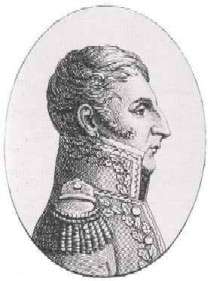Louis-Vincent-Joseph Le Blond de Saint-Hilaire
Louis-Vincent-Joseph Le Blond, comte de Saint-Hilaire (4 September 1766 – 5 June 1809) was a French general during the Revolutionary and Napoleonic Wars.[1]
Louis-Vincent-Joseph Le Blond, comte de Saint-Hilaire | |
|---|---|
 General Count Saint-Hilaire. | |
| Born | 4 September 1766 Ribemont, France |
| Died | 5 June 1809 (aged 42) Vienna, Austria |
| Buried | Panthéon, Paris |
| Allegiance | |
| Service/ | Infantry |
| Years of service | 1777-1809 |
| Rank | General of Division |
| Battles/wars | French Revolutionary Wars, Napoleonic Wars |
| Awards | Count of the Empire |
Early career
Born in Ribemont, Aisne, Louis-Vincent-Joseph Le Blond de Saint-Hilaire seemed destined for a military career, as he was the son of a cavalry captain and showed inclination for such a profession quite early on.[2] In 1777 he entered the Conti-Cavalerie cavalry regiment as a cadet and 15 years later he was named captain, taking part in the Siege of Toulon, then was with the Army of Italy, where he knew rapid promotion, despite his aristocratic ascendance. A general of brigade in 1795, he was wounded at the battle of Loano, losing two fingers. He served as commander of Toulon and Marseille and was promoted to general of division at the end of 1799.[1][3]
Napoleonic Wars
From 1805 onwards, he would continually serve in the Grande Armée, holding various divisional commands. In 1805, he commanded a division in Jean-de-Dieu Soult's IV Corps during the War of the Third Coalition and at the battle of Austerlitz he conducted a noted and decisive assault on the Pratzen plateau, receiving a serious wound at the beginning of the assault but nonetheless retaining his command for the rest of the battle. Between 1806-1807, he fought with distinction at Jena, Eylau and Heilsberg. He was created count of the Empire in 1808 and received a divisional command in the newly created Grand Army of Germany, with which he would campaign in southern Germany and Austria. On 22 April 1809, at the climax of the Landshut Campaign, Saint-Hilaire distinguished himself under Napoléon's eyes at the Battle of Eckmühl. As the Austrian army retired from the field, the French Emperor had the division paraded, and told its commander in front of his men, "Well, you have earned your marshal's baton and you shall have it."[4]
On 22 May 1809 Saint-Hilaire had his left leg torn off by a cannonball at the battle of Aspern-Essling and died of gangrene 15 days later, as a result of this wound, before he could be officially inducted to the Marshalate. In 1810, Napoleon I ordered his remains interred in the Panthéon alongside Marshal Jean Lannes. The name Saint-Hilaire is inscribed under the Arc de Triomphe in Paris.[1][3]
References
- Fierro; Palluel-Guillard; Tulard, p. 1075.
- de Courcelles, p. 352.
- de Courcelles, p. 352-356.
- David G. Chandler, The Campaigns of Napoléon, Weidenfeld and Nicolson, London, 1966, p 694
Sources
- Chevalier de Courcelles - "Dictionnaire historique et biographique des généraux français", 2nd volume, Beaul-Bouq, 1821. consult online
- Fierro, Alfredo; Palluel-Guillard, André; Tulard, Jean -"Histoire et Dictionnaire du Consulat et de l'Empire”, Éditions Robert Laffont, ISBN 2-221-05858-5